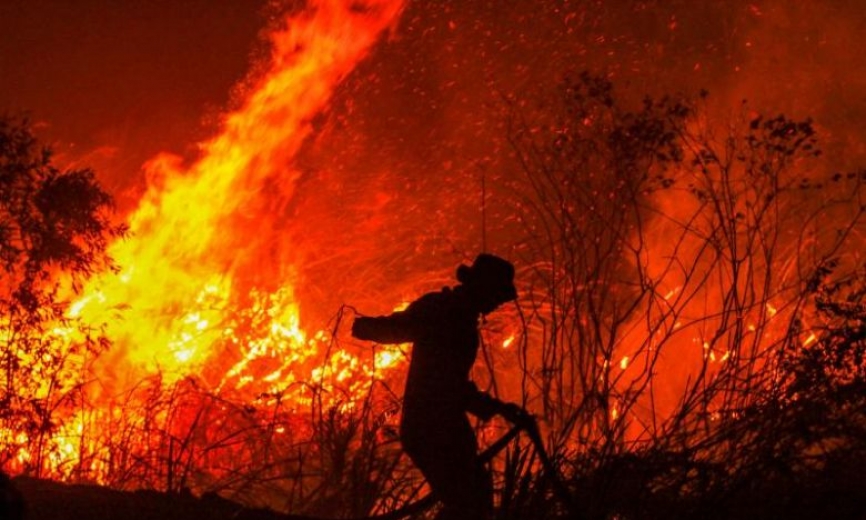 A forest and land fire task force's officer is trying to extinguish the hotspot. (Image via The Strait Times)
A forest and land fire task force's officer is trying to extinguish the hotspot. (Image via The Strait Times)
Hotspots increase in Sumatera to 610 despite water-bomb and rain
Despite the local government’s effort in water-bombing the hotspots and even, nature itself lent its hand through the rain, the hotspots in the South Sumatera region increased significantly instead.On Tuesday, the satellite of the National Institute of Aeronautics and Space (LAPAN) caught 1,361 hotspots in Indonesia, and 610 of it came from South Sumatera. This might be caused by the fire in the peat that was not touched by the water from the rain nor the water-bomb.
According to the Forestry Service of South Sumatera, the number of hotspots in the province increased significantly compared to three days ago where there were 63 hotspots last Saturday, 198 last Sunday, and 87 on Monday.
Even though the province was drenched by a 4-day rain from 24 to 27, the rain intensity was said only to extinguish the fire on the surface, but not in the peat. The region with the most hotspots was Ogan Komering Ilir (OKI) regency with 505 hotspots.
The regency has the most spacious peat area especially in Pampangan, Cengal, and East Pedamaran districts. For these three districts, only water-bomb that works, thrown from the helicopter. These districts are inaccessible on land.
However, even the water-bomb was said only to extinguish the fire on the surface. The peat is 30-meter tall, and the fire in the peat was not extinguished by the water.
To prevent the hotspots from spreading, Forest and Land Fire Task Force (Satgas Karhutla) ordered personnel in Ogan Ilir regency to handle OKI regency. For the air quality, PM10 concentration reached the "Very Poor" category with the worst at 625 - 650 µg/m3.
Source: https://bit.ly/2pkoomr
 English
English Japan
Japan

tractor supply ivermectin buy stromectol uk can you buy ivermectin over the counter ivermectin stromectol where to buy
lasix kidney 12.5 mg furosemide hydrochlorothiazide 25 mg vs furosemide 40 mg which side effect is associated with furosemide?
pfizer viagra prices generic viagra price at cvs viagra generic female enhancement pills that work top 10 supplement brands generic viagra safe pharmacy
prednisone irritability prednisone for gout why does prednisone give you more energy when can i take ibuprofen after finishing prednisone
lasix horse furosemide oral solution 10mg ml how long dose it take for lasix to hit the system
furosemide toxicity cost of furosemide 40 mg furosemide interactions with other drugs how to order furosemide without prescription from canada
$4 generic drugs at walgreens viagra trial samples snorting viagra does libido max really work c# generic number walgreens in store photo specials viagra how much to take viagra users group cost of viagra in philippines lowest price cialis 5mg doctor x viagra tadalafil 20 mg reviews good rx pharmacy discount walmart viagra women viagra 100 mg best price side effects of generic viagra best diet pill for women over 60 rx direct online viagra tablets australia free printable card templates walmart cialis prices generic alternative to viagra generic viagra available in usa red viagra tablets free birthday printable coupons improve male libido naturally reliable pills website review sildenafil for hypertension viagra gum how to prescribe xiidra penile enhancement surgery near me viagra tablets pink ladies costume from grease sildenafil citrate for women
is albuterol cost of albuterol inhaler without insurance a nurse is caring for a client who is taking albuterol
amoxicillin cause diarrhea amoxicillin 500mg capsules uk can you alcohol with amoxil substitute for amoxicillin
modafinil blues purchase modafinil online how long does modafinil work where is alembic pharmaceuticals modafinil
amoxil poisoning purchase amoxicillin uk amoxicillin for cold amoxicillin cvs
medication samples for healthcare providers top 10 enhancement pills kroger 4 dollar prescription list viagra pfizer tadalafil 20 mg lowest price india cost of trulicity pen grapefruit pectin side effects
amoxicillin dental prophylaxis kroger amoxicillin price amoxil generic name on sale amoxicillin yeast infection
amoxicillin and weed amoxicillin for sale uk amoxicillin pink liquid amoxicillin treatment
nuvigil or provigil generic provigil cost ritalin vs modafinil for studying how big are modafinil pills
albuterol vs levalbuterol ventolin prescription buy albuterol sulfate inhalation solution how to order ventolin online
lowest prices on viagra cenforce 200 viagra price sildenafil 100mg for sale when will cialis go generic red fortera male enhancement pill
generic ventolin inhaler generic albuterol no prescription how often can you use ventolin inhaler how long does tachycardia last after albuterol
levemir patient assistance program viagra in action video cost of viagra sildenafil citrate 100mg india why does cialis cost so much sildenafil tablets 20 mg